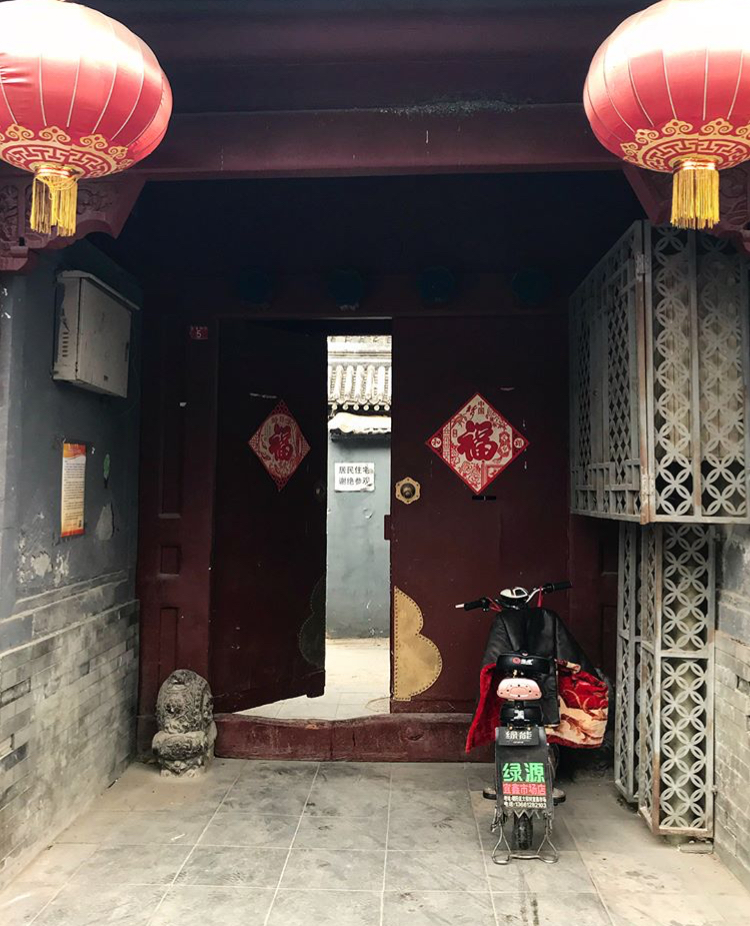There are many things that shocked us about Beijing the first few days we were here. One of them, which has had a trickle-down effect on all of our actions within the city, has been its epic, sprawling layout. It’s easy to look at a map, see that something is a block away and assume you can get there with a quick stroll…only to see on Google Maps that it’s a 35 minute walk away. It’s unreal.
Additionally, we’ve been extremely pleased to discover that although our hostel is a mere few (gigantic) blocks from the Forbidden City and Tiananmen Square, it is in a hutong that is completely local and devoid of westerners or other touristic features. The result is that every restaurant or shop is where local Beijingers(?) live and function on a daily basis.

A typical street scene in our hutong (neighborhood).
These descriptions are relevant (I promise) because they explain why there isn’t really, from what we’ve seen, a central row of stores or restaurants that cater to Westerners and facilitate shopping, souvenir purchasing, eating or the like. The result, which is somewhat unique relative to my previous travel experiences, is that the prime shopping opportunities in Beijing are located in isolated markets that are massive and centered on specific types of goods (e.g., a specific market specializing in pearls; one specializing in animals; one specializing in luxury goods, etc.).
In our infinite curiosity, we decided to visit a few of them in order to perform some practical (and impractical) shopping, which led us to discover just how disparate these markets are and how important it is find the right one for your purposes.
Panjiayuan Flea Market (Antique Market or Dirt Market) – Too Hot
On a rainy day, decided to head to this market which was a short taxi ride away from our hostel because it was highly recommended by several blogs and guide books. Frankly, my expectations were super low. It used to be commonly referred to as the “dirt market” because local citizens would go there to this market in a large field to sell the items they had unearthed in the dirt. Obviously this historical context facilitates outsized expectations of high quality goods in a luxury setting!
Suffice it to say, we were pleasantly surprised when our taxi rolled up on a fairly new, orderly and well-developed physical structure full of booths selling an array of goods. Far from being mere junk, it was full of remarkable items displaying incredibly ornate and beautiful craftsmanship that had us lunging for our wallets. These ranged from delicately painted porcelain vases, gigantic gem stones which were fashioned into unique displays and, my personal favorite, these phenomenal knotty pieces of wood that made great centerpieces and included carvings of cool Chinese figures. Additionally, there was a whole floor of the market dedicated to historical items of the Chinese revolution, including military artifacts, old maps, Mao Zedong statutes, propaganda posters and other fascinating knickknacks. Finally, there were zero westerners there – it was exclusively full of local Beijing citizens – and there was no pushiness, just super friendly and borderline meek vendors. Perfect.
While all of this was very cool and of a much higher quality than we ever expected, we weren’t in a position to pull the trigger to buy anything (despite me desperately wanting the knotty wood centerpieces!) because it just didn’t feel right. They were the type of goods you buy for your home, which was hard for us because, well, we don’t have one, won’t for a while and can’t even begin to think about what it will look like once we do. It feels like we’d be shopping for a completely different reality from what we can comprehend.
The result was, while it is an awesome market, we didn’t end up buying anything here other than a tiny, cheap “good luck” snail figurine for Jess, in part to assuage her aching desire to spend money on frivolous goods. (Editors note: hey! It’s a really cute snail!) Instead, we window shopped like eager children at a toy store and finished our morning there with an absurdly delicious lunch at a restaurant called The Beijing Rhythm, which we were fortunate to stumble upon in a rain storm.
Xiushui Market (Silk Market) – Too Cold
After our morning visit to the Antique Market, Jess still had the shopping itch (which I’ve never possessed). Therefore, we caught a cab in a light rain storm (an adventure itself!) and headed to the Silk Market, which promised a more traditional (read: touristy) shopping experience. This is because it is a perfect example of the type of shopping that most tourists expect to have in China – a massive shopping mall filled with counterfeit designer goods and excessive haggling that is visited almost exclusively by Westerners seeking to load up on presents and pretentious goods.
Unfortunately, we were intimately exposed to each of these features of the market, largely for the worse. I had reached my shopping limit for the day and didn’t want to confront the massive scale of the mall, so I grabbed a latte at a coffee shop with WiFi and sent Jess off alone for 1.5 hours to shop to her heart’s content. I was surprised when she returned a mere 45 minutes later covered in disappointment. They exclusively had designer counterfeit goods in the mall (i.e., fancy suits, dresses, high heels and purses), which didn’t exactly jive with our current backpacking vibe. So even though Jess went in search of simple Toms slip on shoes, she couldn’t find any through the tangled web of 6 inch heels.
Additionally, Jess was exasperated by the haggling at the market. It was hard to blame her. Beyond normal haggling, the Silk Market is known for its particularly aggressive environment. Because I wanted to support her shopping desires, I told her I’d take a lap of the store with her and help haggle for whatever goods interested her. We stopped at a store with (allegedly) cashmere sweaters that interested Jess, so we asked the price. The store worker started at 1000 yuan ($150 USD), which I scoffed at and suggested a mere 110 yuan (we had heard that starting around 10% of the initial price was a good starting point). “You crazy! You no buy ice cream for 110 yuan!,” she exclaimed. It devolved rapidly from there. It was hard to haggle over the yelling and insults being hurled by the store worker, so we just walked away to the sound of her shouting, “Hey, where you going! We haggling here!”
Suffice it to say, same as with the Antique Market, we didn’t buy anything at the Silk Market. What was interesting was that the result was the same, but for wildly different reasons and based on completely opposite experiences. It just didn’t meet our needs and was way too ridiculous.
Hongqiao Market (Pearl Market) – Just Right
The next day following our debacles at the Antique Market and Silk Market, we decided to take one final stab at visiting a market in Beijing to pick up some goods. Our first few days in China had exposed some flaws in our packing list that we really needed to address (read: it’s cold here). After a morning visiting the Temple of Heaven, we decided to hop over to the nearby Pearl Market to try our final bit of luck at shopping.
Everything about this place was different. For one, the market was a very nice balance of practical goods that we actually needed on a daily basis, as well as some less practical items that would make good gifts. There was a nice mix of local Chinese citizens and Westerners, which was a nice contrast to the Silk Market. Finally, there was some haggling, but it felt far more reasonable than at the Silk Market – where you would clearly need to in order to get the price down, but the vendors were going to not be gigantic a-holes along the way.
Having found our ideal destination, we got to shopping. Since we’re each reluctant hagglers, we had a real mixed-bag of results via our efforts. You always feel somewhat successful because you can usually get the price down at least 50% from what they originally proposed, if not more. But with that said, you generally always feel like you probably got screwed at least a little bit along the way. By the end we were gauging our success by how happy the vendor was once we agreed on a price. If they were smiling and friendly, then we know we got a crappy price. If they were reluctant to make eye contact, walked away immediately and generally wanted nothing to do with us, then that means we got a solid price.
An example of the haggling travails was when Jess and I each, in separate instances, bought a light, packable North Face rain coat. Jess found it first and bought one after haggling with them for a bit, but warned me that she probably paid too much. When Jess took me back to that store to buy one, this was proven by how happy the vendor was to see her. They chatted amicably and showed me the same coat in a proper size. When we asked the price, the vendor joked that she’d charge me more because there was more fabric than for Jess’s coat (since I’m a large human), but immediately said she’d give me the same price – thinking that the market had been set. I took advantage of the situation to say that I wouldn’t pay that price – that Jess paid too much and I wanted it for less. The vendor’s smile turned to scowl as we commenced haggling over the price, with me ultimately getting it for 30% less than Jess. Near the end the vendor basically hated me, telling Jess “Your boyfriend too hard! Too cheap!,” to which Jess just shrugged wearily and said, “Oh, I know.”
Don’t let the story fool you – I’m not a good haggler either and got bad prices plenty of time. But it was cool to really start to learn the process and get practice at it as we meandered through the market looking for various goods. We managed to load up – Nikes, a raincoat, socks and a beanie for me, while Jess got Toms, a raincoat, leggings, a beanie, T-shirt, socks and an iPhone cover – and not hate the process along the way.
We ended the day with a victorious meal at a nearby restaurant, along with a newfound patience for what to expect both in terms of the type of shopping and the experience we should come to expect while travelling. Not every store will have what we need and haggling will be necessary, but there’s a way to thread that needle to get what we need. Fingers crossed that we manage to nail this going forward!


